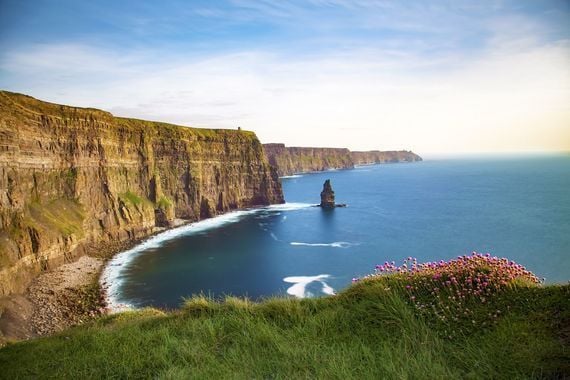A fascinating world map reveals the most popular tourist attraction in almost every country, with the Cliffs of Moher, in County Clare, representing Ireland.
The map, which is based on more than five years of Wikipedia page view data, has replaced country names with the national landmark that is most frequently researched on Wikipedia.
Produced by travel insurance firm AllClear, the map includes 32 cultural and historic sites, 32 parks and nature reserves, 26 ancient ruins, 20 mountains and volcanoes, 17 bodies of water, 15 religious landmarks, nine islands, seven modern architectural sites, and two deserts.
The Cliffs of Moher, which received more than 1.9 million page views on Wikipedia over the past five years, represents Ireland on the map.
The rugged seacliffs tower over Ireland's Atlantic coastline, near the village of Liscannor, and allow tourists to enjoy a spectacular view of the Aran Islands and the Atlantic Ocean. Visitors are able to walk a safe trail on top of the cliffs and gaze down the sheer 700-foot drop to the ocean below.
The cliffs are among the most popular tourist attractions in Ireland and were recently named Ireland’s Best Visitor Attraction in the Irish Independent’s annual Reader Travel Awards for 2023.
The Statue of Liberty represents the USA on the new map, with Wikipedia page views for the famous monument numbering 19.8 million.
The UK was represented by Stonehenge, which has received 13.5 million views, while Australia is represented by the famous Great Barrier Reef (5 million page views).
The Eiffel Tower (17 million views) and the Colosseum (12 million views) represent France and Italy, respectively, while Spain is represented by the Sagrada Familia, in Barcelona (11 million views).
Here's a short video that gives a taste of what's in store at the Cliffs of Moher:
Interesting facts about the Cliffs of Moher
Impressive height: The Cliffs of Moher reach a maximum height of approximately 702 feet (214 meters) above sea level. They stretch for about 5 miles (8 kilometers) along the Atlantic Ocean coastline.
Geological formation: These majestic cliffs were formed around 320 million years ago during the Carboniferous period. The rock layers consist primarily of shale, siltstone, and sandstone.
O'Brien's Tower: At the highest point of the cliffs stands O'Brien's Tower, a round stone tower built in 1835 by Sir Cornelius O'Brien. It was constructed as an observation tower to provide tourists with panoramic views of the cliffs and the surrounding area.
Birdwatching haven: The Cliffs of Moher are home to a variety of seabirds, including puffins, razorbills, guillemots, and kittiwakes. Birdwatchers flock to the area to observe these fascinating creatures during the breeding season, which typically runs from April to July.

Are you planning a vacation in Ireland? Looking for advice or want to share some great memories? Join our Irish travel Facebook group.
Visitor center: There is a modern visitor center at the cliffs that offers interactive exhibits, audiovisual presentations, and information about the natural and cultural history of the area. It provides valuable insights into the geology, wildlife, and history of the cliffs.
"Harry Potter" connection: The Cliffs of Moher were featured in the film "Harry Potter and the Half-Blood Prince." They served as the backdrop for the Horcrux cave scenes, where Harry and Dumbledore search for one of Voldemort's hidden objects. Harry and the professor stand on Lemon's Rock off County Kerry with the Cliffs as a backdrop.
The Burren: The Cliffs of Moher are part of the Burren and Cliffs of Moher UNESCO Global Geopark, which covers a larger area of geological and ecological significance. The Burren is known for its unique limestone landscape, with numerous caves, sinkholes, and rare flora.
Conservation Efforts: The cliffs and surrounding areas are protected to preserve their natural beauty and ecological importance. Conservation efforts focus on maintaining the delicate balance of the ecosystem and ensuring sustainable tourism.




Comments